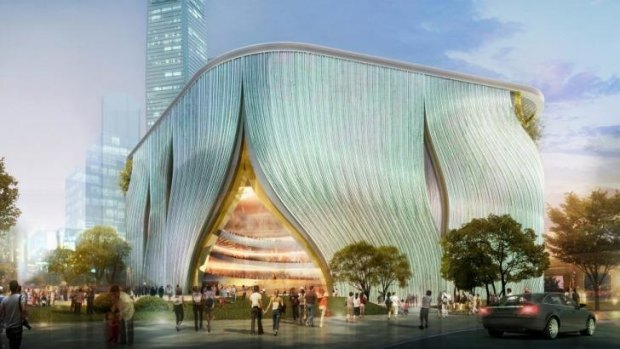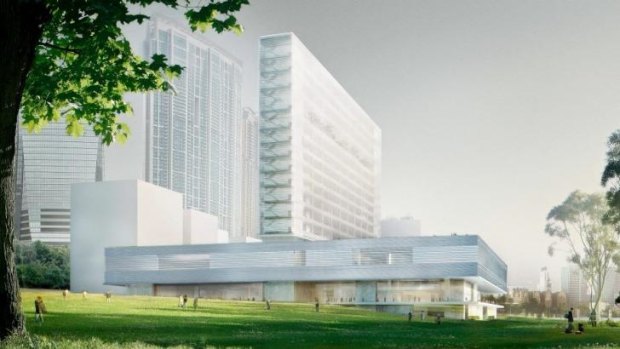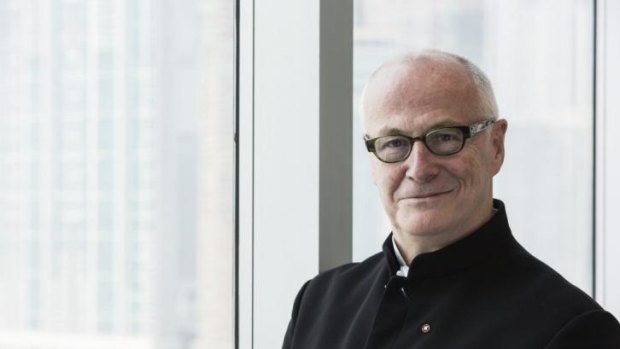The first head of the West Kowloon Cultural Authority development lasted just a couple of days. The second only slightly longer, a few months.
It says a lot about Michel Lynch, CBE, AM - the former head of the Australia Council, Sydney Opera House, Sydney Theatre Company and London's South Bank and Royal Festival Hall - that he has lasted three-and-a-half years in the job.

Street-level view of the Xiqu Centre in the Kowloon Cultural District.Credit: BTA & RLP Comany Limited and West Kowloon Cultural District Authority.
And what a job it is. With a budget of more than $2 billion to create one of the world's biggest cultural precincts from scratch, on a site that was only recently reclaimed from the harbour, Lynch could be forgiven for sometimes feeling like he has bitten off more than he can chew.
Not that you'd know that from the 63-year-old's distinctive cackle of laughter that rises above the polite hubbub of the annual briefing on the project in Hong Kong, coinciding with the second iteration of the city's art fair since it was taken over by Art Basel, the Swiss cultural event that also has an offshoot in Miami Beach.

View of M+ from the park at West Kowloon Cultural District in Hong Kong.Credit: Courtesy Herzog & de Meuron and West Kowloon Cultural District Authority.
For a man with so much responsibility and such a big budget on his shoulders, he seems undaunted at the prospect of not only building the complex, but filling it - especially the massive 26,000 square metre M+ museum for visual culture - with art works, and scheduling performances in the many venues that will operate within the 23-hectare precinct.
To that end, this week he and M+ executive director Lars Nittive, the inaugural director of London's Tate Modern, announced the museum's latest acquisition - British artist Antony Gormley's monumental 2003 sculpture Asian Fields. Seen in Australia at the 2006 Sydney Biennale, the work comprises more than 210,000 hand-sized clay sculptures, created with the help of more than 350 people from the village of Xiangshan in southern China.
Gormley's piece, which requires 2000 square metres of exhibition space, was acquired with the help of a $US1 million ($1.07 million) donation from an unnamed Hong Kong philanthropist. It is one of a series of works purchased for M+ with the help of donors. Indeed, the bulk of the collection comes from two in particular: the 1500-piece donation of contemporary art from Dr Uli Sigg (a Swiss media executive, former ambassador to China and influential art collector) and Shanghai-based collector Guan Yi, who donated a large collection of works by southern Chinese artists exhibited at the 2003 Venice Biennale.
The museum will house more than 3000 works, purchased with the help of $HK1.4 billion ($193 million) in cash donations, in addition to funding for acquisitions. They have so far spent $300 million acquiring art works for the museum. The project received $3 billion in government funding in 2008, which Lynch and his team have through investment grown by about $300 million during that time, despite the global financial crisis which hit soon after.

Head of the West Kowloon Cultural Authority development: Michael Lynch.Credit: West Kowloon Cultural District Authority.
Lynch has built a formidable team of managers, including Nittive, and brought back Hong Kong-born and bred curators who had spent time working at major arts institutions such as New York's Museum of Modern Art, to curate the collection to be displayed at the museum.
The development reflects the growing maturity and sophistication of Hong Kong's arts scene. No longer just a shopping destination for tourists, it now boasts offshoots of some of the world's biggest commercial contemporary galleries and has received a major shot in the arm with the arrival of Art Basel.
But first, they have to build it, and the rest of the precinct.
"I guess we're at the tricky point of having to realise the first part of the vision, to make sure the overall scale of the thing is realised," Lynch says of the project, due to open in stages from 2015. The first cab off the rank is the Arts Pavilion, an events space for artists and designers, to be followed by the Xiqu Centre, dedicated to Chinese and Cantonese opera.
It hasn't been without its setbacks, with delays to the building of a major new train line to mainland China, which cuts under the site, slowing the progress of works.
"That's not without its challenges, to get the six venues up and running," says Lynch. "There are things we have no control over, like railways to China or holes in the ground.
"We think with those first venues up and running, then we will have created a real sense on at least half of the site that the vision was worthwhile and the politicians and the people will feel that substantial investment was worthwhile and that it's worth persisting with.
"It will probably take another 10 to 15 years before the story is totally realised.
"When I came in, my two predecessors, one of them had been here a week and one less than five months. I've now done my first three years, but I was brought in very much to get the thing happening and to be really able to hand it over to local people who can carry it on."
The writer travelled to Hong Kong as a guest of the Hong Kong Economic & Trade Office.